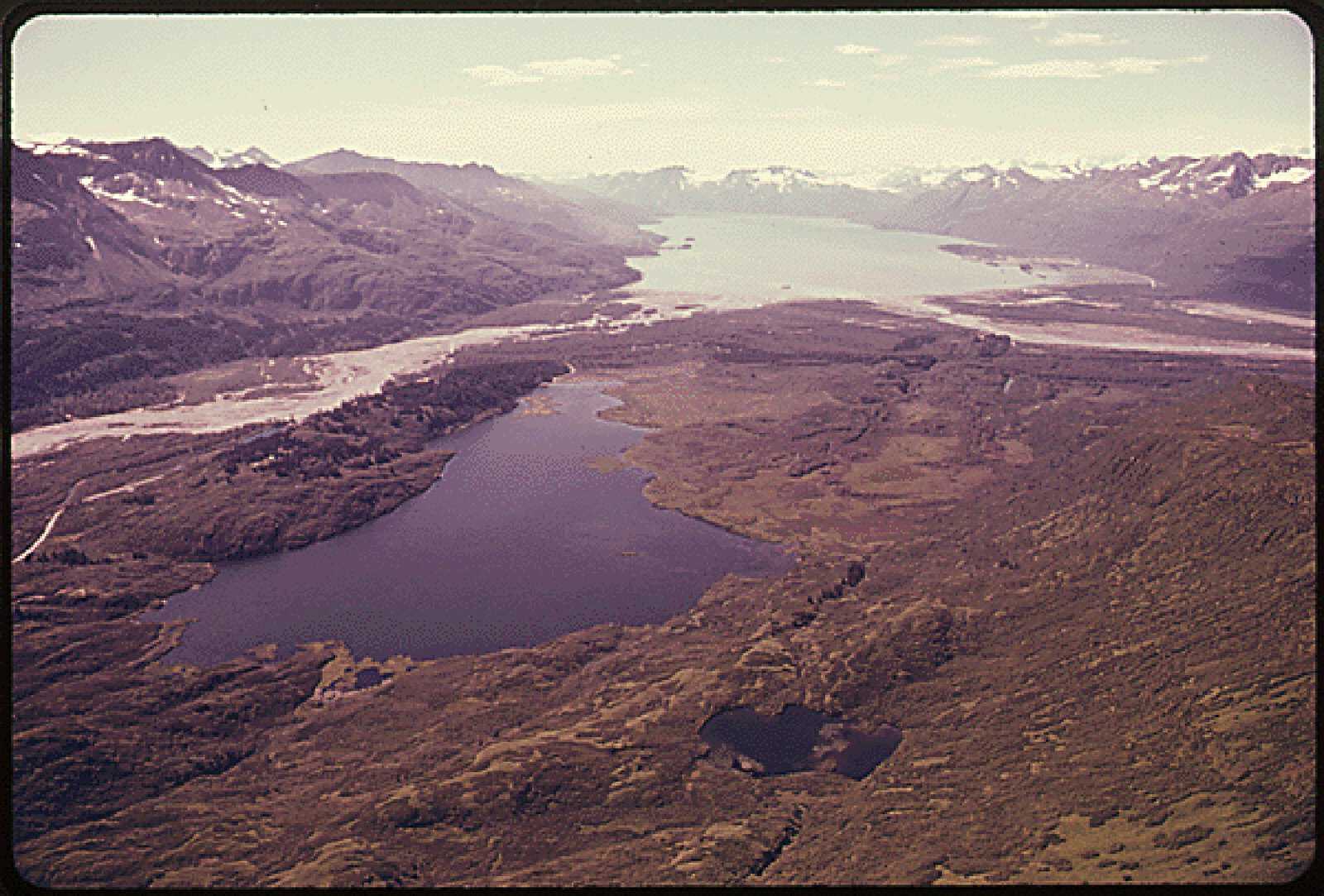Alaska Pipeline Chronology

1959
January 3: President Dwight D. Eisenhower signs the official declaration making Alaska the 49th American state.
1966
October: Native leaders from across the state form the first statewide Native organization, the Alaska Federation of Natives (AFN), to advocate for Alaska Native interests. From 1966 to 1971, AFN will be at the forefront of the political battle over native lands.
December: Interior Secretary Stewart Udall imposes a "land freeze." The freeze stops the federal government from giving the state of Alaska land titles as agreed under the Statehood Act. This gives Alaskan Natives time to settle outstanding claims. The federal government has already given out provisional titles to 12 million acres, including Prudhoe Bay, where oil companies will make their oil find.
1968
March 13: Atlantic Richfield Company (ARCO) and Humble Oil and Refining Company (now Exxon Company, U.S.A.) announce the discovery of a massive oild field in Prudhoe Bay on Alaska's northernmost coast, in the frigid Arctic Circle. Geologists estimate the equivalent of nearly 10 billion barrels of crude oil is there in the ground. It is the largest oil field ever discovered in North America.
Oct 28: ARCO joins up with Humble Oil and British Petroleum Oil to form the Trans Alaska Pipeline Systems (TAPS). They enter into an "agreement for a planning study and for engineering design and construction of the Trans-Alaska pipeline project."
November: Under direct orders from Governor Walter J. Hickel, Alaska's Department of Highways begins blazing a winter road just north of Fairbanks to Prudhoe Bay. The road will be abandoned one month after its completion in March 1969.
1969
February 10: TAPS announces plans to build a hot oil pipeline from Prudhoe Bay in the Arctic Circle to Valdez on Alaska's south coast. The original plan is to bury the pipe the whole way.
June 6: TAPS files for federal right-of-way permits. Seventy-five percent of all land in Alaska is still federally owned.
September 10: The lease for 179 parcels of land covering 640 acres of state-owned land in and around Prudhoe Bay is put up on the auction block. Alaska's coffers become richer by $900 million.
September 13: In preparation for the pipeline, $100 million worth of 48-inch steel pipes arrives in Valdez from Japan. These pipes will lay rusting for more than five years before they are put to use.
1970
March 5: Five native villages north of Fairbanks oppose the oil pipeline plan by filling suits against both the oil companies and the Department of Interior. In state court, the suit claims TAPS has failed to honor a previous agreement to hire Native contractors and laborers for the project. A second suit is filed against Walter J. Hickel, who is now President Richard Nixon's Interior Secretary, in federal district court. The suit demands the government forego any construction until Natives along the pipeline's route give consent.
March 26: Environmental groups including the Wilderness Society, Friends of the Earth, and the Environmental Defense Fund file their own suit, claiming the TAPS proposal violates both the Mineral Leasing Act of 1920, which restricts the right of way to 50 feet (TAPS needs 100 feet), and the newly passed National Environmental Policy Act, which requires the study of the environmental impacts of the proposed pipeline and alternative ways of getting the oil to market.
April 3: In federal district court Judge George L. Hart issues a temporary restraining order prohibiting the Department of the Interior from issuing a construction permit for a road that crosses native land near Stevens Village.
April 13: Judge George L. Hart issues a preliminary injunction against the entire pipeline project. It is the first major test of the National Environmental Policy Act. After just two months of legal maneuvering, TAPS is stopped dead in its tracks.
April 24: Secretary of the Interior Walter J. Hickel says he will issue a right-of-way permit for the construction of the pipeline when he can guarantee it will be built safely. Little does anyone realize that it will take more than three years to get authorization.
August 14: The owner oil companies create the Alyeska Pipeline Service Company to oversee the management and building of the Trans-Alaska pipeline. Alyeska's first task is to get the pipeline project going again.
December: Government geologists release a document titled "Some Estimates of the Thermal Effects of a Heated Pipeline in Permafrost," which explains the damaging effects a hot oil pipeline would create in permafrost. Critics of the pipeline use the document to support their case.
1971
January 1: The Department of the Interior submits the first draft of an environmental impact statement. It is a scant 196 pages long, with an additional 60 pages of revised construction plans.
February: Public hearings are held in Washington, D.C., and Anchorage, Alaska, to discuss the environmental impact statement. By March, there will be more than 12,000 pages of testimony, the great majority of it critical of the pipeline.
December 18: President Richard Nixon signs into law the Alaska Native Claims Settlement Act. This new law gives Alaska Natives the right to select 44 million acres of land and a cash settlement of nearly $1 billion. Half of the money is to be paid from oil production royalties.
1972
March 20: The Department of the Interior releases the final environmental impact statement. The original 256-page document has now ballooned to a nine-volume comprehensive study on both the environmental and economic impact the pipeline will have. The release is followed by a 45-day review period in which environmental groups go over the impact study before any decisions are made.
May 11: A new Interior Secretary, Rogers C. B. Morton, grants the right-of-way permits for the Trans-Alaska pipeline. He promises that construction will be strictly monitored to protect the Alaskan environment. The only thing standing in way of the pipeline is Judge Hart's preliminary injunctions.
August 15: Judge Hart calls the environmentalists back to court. He rules in favor of the defendants: the Department of the Interior, Alyeska and the state of Alaska. In Hart's opinion, the pro-pipeline coalition has now met all the legal requirements. The preliminary injunction is dissolved. The environmentalists appeal the ruling to the U.S. Court of Appeals in Washington, D.C.
1973
February 9: The appeals court partially overturns Judge Hart's ruling. The court says it has no jurisdiction over the right-of-way limits in the Mineral Leasing Act of 1920. Congress will have to grant authorization to allow a right of way more than fifty feet wide. Alyeska Pipeline Service Company's plan includes a 100-foot-wide right of way.
July 17: With a vote of 50 to 49, the Senate narrowly passes the Gravel Amendment which declares that the Department of the Interior has fulfilled all the requirements of the National Environmental Policy Act, allowing Alyeska to move forward. Vice President Spiro Agnew casts the deciding vote.
October 6: On the Jewish holy day of Yom Kippur, Egyptian forces attack Israel, while at the same time Syrian troops assault the Golan Heights in a surprise offensive. With help from the United States, Israel succeeds in reversing the Arab gains. The clash will have repercussions for the U.S. oil supply.
October 17: The Organization of Petroleum Exporting Countries (OPEC) strikes back against the United States and the Netherlands for their support of Israel in the war. OPEC imposes an oil embargo. Overnight, the price of a barrel of oil rises from $3 to over $5. Gas at the pumps will soon rise from 30 cents per gallon to $1.20, and drivers will wait in long lines to fill up their tanks.
November 16: In direct response to the oil crisis, President Nixon signs the Trans Alaska Pipeline Authorization Act into law. Nixon introduces "Project Independence" in a televised speech: "Throughout history, America has made great sacrifices of blood and also treasure to achieve and maintain its independence. In the last third of this century, our independence will depend on maintaining and achieving self-sufficiency in energy."
December: The price of a barrel of oil rises to $11.65.
1974
January 3: The Department of the Interior grants Alyeska a federal permit for right of way, allowing construction to start.
April 29: Construction begins on a haul road that will link the Yukon River to Prudhoe Bay. Truckers will use the road to transport goods to the North Slope as well as to camps along the way.
September 29: The haul road is finished. It is the first American highway to cross the Arctic Circle.
1975
March 27: Construction begins on the Trans-Alaska pipeline. Workers bury the first section of pipe beneath the Tonsina River. The pipe floats back to the top and then is re-buried.
July: Alyeska suffers its first scandal. A subcontractor is found cutting corners by falsifying weld x-rays. Thirty thousand eight hundred welds are in question. The x-rays are used to inspect all of the girth welds around the pipe's circumference. It will take Alyeska a year to check all the x-rays and to repair the sub-par welds.
1976
December 6: The last piece of pipe is laid down near Thompson Pass, where welders and laborers have had to scale near-vertical mountain walls to install pipe.
1977
May 31: Welders complete the last of the 100,000 girth welds near Pump Station 3. The final price tag for the pipeline is over $8 billion dollars -- nearly nine times the original estimate. Much of the money has gone to building the pipeline to be environmentally safer than was originally planned.
June 20: The first oil flows from Pump Station 1 down the pipeline.
July 28: The first oil reaches the Valdez Marine Terminal.
August 1: The tanker ARCO Juneau departs Valdez with the first shipment of North Slope crude oil.
1980
January 22: After 2-1/2 years of pipeline operations, the one-billionth barrel of oil arrives at the Valdez Marine Terminal.
December 2: President Jimmy Carter signs in to law the Alaska National Interest Lands Conservation Act (ANILCA). The statute protects over 104 million acres of federal lands in Alaska, effectively doubling the size of the country's national park and refuge system.
1988
March: Oil output peaks on the Trans-Alaska pipeline. For the entire month of March, the line transports 2.1 million barrels of oil a day. The amount of oil subsequently pumped out of the ground will decrease at a steady rate.
1989
March 24: The tanker Exxon Valdez fails to steer back in to the shipping lane after trying to avoid an iceberg. Twenty five miles south of Valdez, the tanker runs aground on Bligh Reef, spilling over 11 million gallons of crude oil into the pristine waters of Prince William Sound. The spill threatens an abundance of wildlife: salmon, birds, whales, sea otters, and bald eagles. Exxon will spend more than $2.1 billion dollars over the next few years to clean up the mess.
1994
March 5: The 10 billionth barrel of oil arrives in Valdez. In the late 1960s, geologists had estimated the North Slope would produce no more than that amount. They had underestimated.
2001
May: The pipe transports less than one million barrels a day. Alyeska engineers think it will stay at this volume for the next 10 years.
2002
June 20: Alyeska celebrates the 25th anniversary of pipeline operations.
November 3: A 7.9 magnitude earthquake rocks the pipeline where it intersects with the Denali Fault. Several vertical support members, the structures that hold the pipe above ground, are damaged, but the pipeline remains intact.
November 26: The State of Alaska renews the Trans-Alaska pipeline's right of way permit for another 30 years.
2005
December: The 15 billionth barrel of oil leaves Prudhoe Bay.






